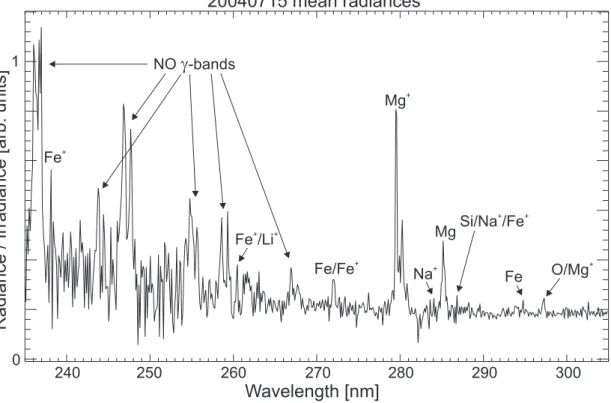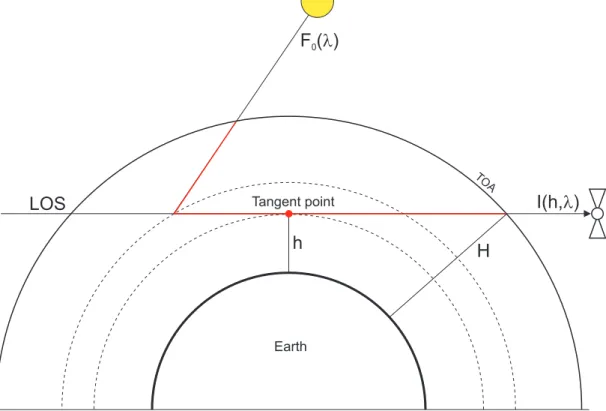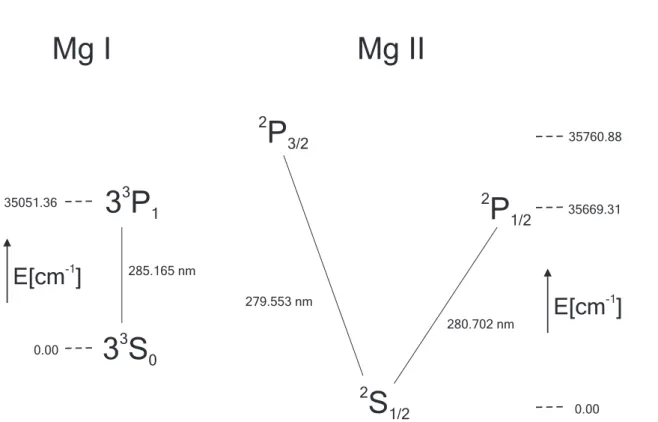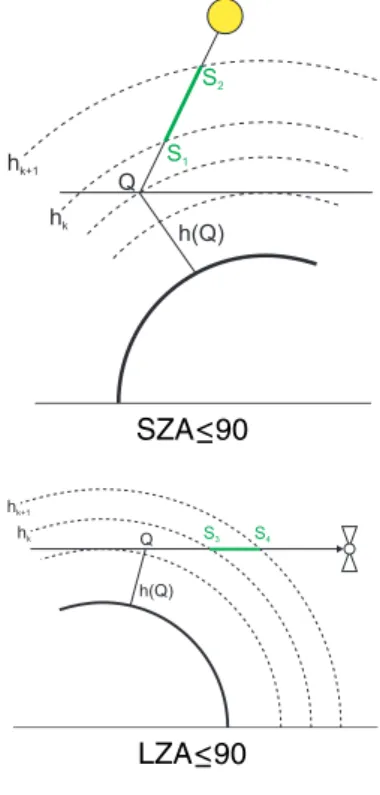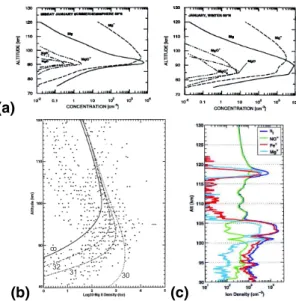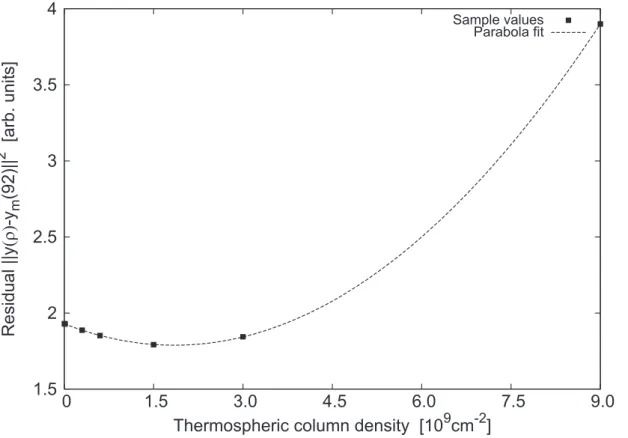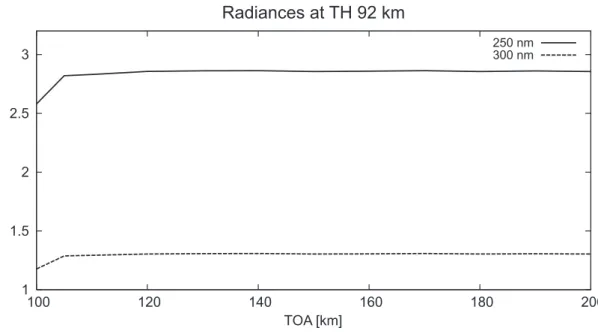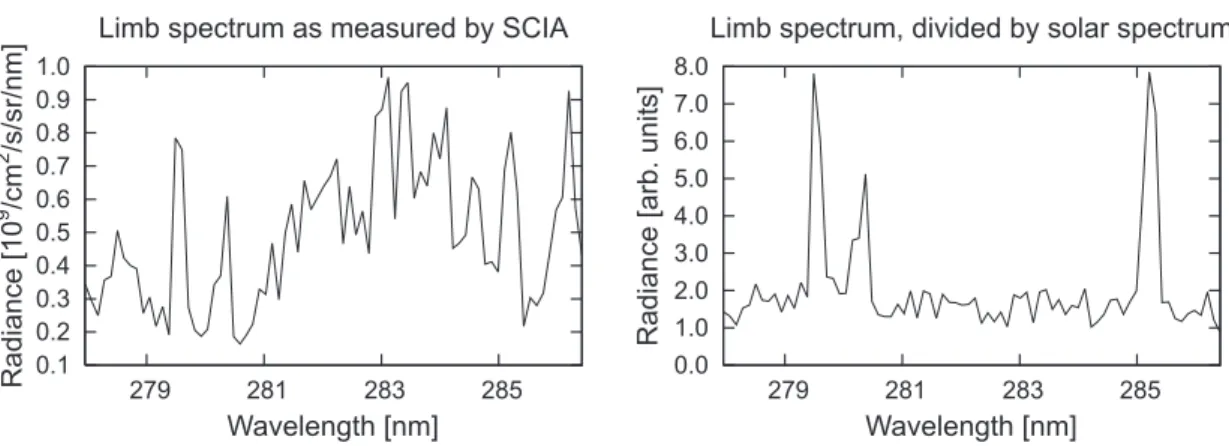ACPD
7, 4597–4656, 2007Mesospheric Mg species from space
M. Scharringhausen et al.
Title Page
Abstract Introduction
Conclusions References
Tables Figures
◭ ◮
◭ ◮
Back Close
Full Screen / Esc
Printer-friendly Version
Interactive Discussion
EGU Atmos. Chem. Phys. Discuss., 7, 4597–4656, 2007
www.atmos-chem-phys-discuss.net/7/4597/2007/ © Author(s) 2007. This work is licensed
under a Creative Commons License.
Atmospheric Chemistry and Physics Discussions
First space-borne measurements of the
altitude distribution of mesospheric
magnesium species
M. Scharringhausen1, A. C. Aikin2, J. P. Burrows1, and M. Sinnhuber1
1
Institute of Environmental Physics, University of Bremen, Bremen, Germany 2
Institute for Astrophysics and Computational Sciences, The Catholic University of America, Washington, D.C., USA
Received: 9 January 2007 – Accepted: 26 March 2007 – Published: 2 April 2007
ACPD
7, 4597–4656, 2007Mesospheric Mg species from space
M. Scharringhausen et al.
Title Page
Abstract Introduction
Conclusions References
Tables Figures
◭ ◮
◭ ◮
Back Close
Full Screen / Esc
Printer-friendly Version
Interactive Discussion
EGU Abstract
We present a joint retrieval as well as first results for mesospheric air density and mesospheric Magnesium species (Mg and Mg+) using limb data from the SCIAMACHY instrument on board the European ENVISAT satellite.
Metallic species like neutral Mg, ionized Mg+ and others (Fe, Si, Li, etc.) ablate
5
from meteoric dust, enter the gas phase and occur at high altitudes (≥70 km). Emis-sions from these species are clearly observed in the SCIAMACHY limb measurements. These emissions are used to retrieve total and thermospheric column densities as well as altitude-resolved profiles of metallic species in the altitude range of 70–92 km. In this paper, neutral Magnesium as well as its ionized counterpart Mg+ is considered. These
10
species feature resonance fluorescence in the wavelength range 279 and 285 nm and thus have a rather simple excitation process.
A radiative transfer model (RTM) for the mesosphere has been developed and val-idated. Based on a ray tracing kernel, radiances in a large wavelength range from 240–300 nm covering limb as well as nadir geometry can be calculated. The forward
15
model has been validated and shows good agreement with established models in the given wavelength range and a large altitude range.
The RTM has been coupled to a retrieval based on Optimal Estimation. Air density is retrieved from Rayleigh backscatter light. Mesospheric Mg and Mg+ number densities are retrieved from their emission signals observed in the limb scans of SCIAMACHY.
20
ACPD
7, 4597–4656, 2007Mesospheric Mg species from space
M. Scharringhausen et al.
Title Page
Abstract Introduction
Conclusions References
Tables Figures
◭ ◮
◭ ◮
Back Close
Full Screen / Esc
Printer-friendly Version
Interactive Discussion
EGU 1 Introduction
The major source for metal species in the upper atmosphere is assumed to be influx of meteoric particles and cosmic dust. These particles enter the atmosphere at high velocities (12–72 km/s) and evaporate in the middle and upper atmosphere due to fric-tional heating with the ambient air.
5
The altitude of evaporation depends on the evaporation temperature of the species considered here. More volatile compounds ablate at higher altitudes. Table 1 gives an overview over evaporation points and approximative altitude ranges of maximum ablation of some species. Additionally, the relative abundances by mass in cosmic dust are given (abridged fromPlane,2003).
10
The ionic counterparts of the neutral metal species are formed by either charge transfer with nitrogen or oxygen or one of the ionization processes described below (see Sect.1.1).
At altitudes between 50 and 100 km, the intensity of solar radiation in the UV is strong, and thus the atmosphere is partly ionized. Equally, this altitude region can
15
be ionized by precipitating energetic particles from e.g. the sun. These particles are trapped within the radiation belts formed by the Earth’s magnetic field and precipitate to lower altitudes near the auroral ovals or the polar caps.
1.1 Chemistry of Mg and Mg+
In general, the following is true for all mesospheric metals: due to the high ionization
20
rate at high altitudes (above∼90 km), the dominant reactions and processes including metal species are determined by ion chemistry. At lower altitudes, major species for reaction with metal species are O, O2, O3, H, H2 and H2O, and the metals will form stable oxides or hydroxides as their dominant compounds (Plane,2003).
Magnesium is the metal species of highest meteoric abundance. Though the ionized
25
ACPD
7, 4597–4656, 2007Mesospheric Mg species from space
M. Scharringhausen et al.
Title Page
Abstract Introduction
Conclusions References
Tables Figures
◭ ◮
◭ ◮
Back Close
Full Screen / Esc
Printer-friendly Version
Interactive Discussion
EGU the fact that ground-based measurement techniques (lidar, photometry) using the Mg
fundamental emission at 285 nm are impossible due to the strong ozone absorption in the Huggins bands at these wavelengths and lower altitudes.
Intense laboratory studies as well as model simulations have been undertaken (Plane and Helmer,1995) to estimate loss and production processes at respective altitudes.
5
The major loss reactions under consideration are oxidation and ionization:
Mg+O3→MgO+O2 (1)
Mg+O2+N2→MgO2+N2 (2)
Mg+hν(≤162.2nm)→Mg+ (3)
Mg+NO+ →Mg++NO (4)
10
Mg+O+
2 →Mg
+
+O2 (5)
Figure1shows the first-order loss rates of neutral magnesium in different altitudes for a December mid-latitude scenario. Despite some diurnal variability the dominant loss process below 95 km is Reaction (1). Photoionization as well as Reaction (2) play a minor role. The diurnal variations are due to variations in the rate of photoionization
15
(Reactions4,5) and photolysis (Reaction3).
Neutral Mg is mainly recovered by hydrogenolysis of a hydroxyl compound (Eq.8) as well as by oxidation of MgO (Eq.6). The ionic side of reaction pathways (Reactions9, 10) includes dissociative recombination of Mg+ oxides (Eqs.11,12):
MgO+O→Mg+O2 (6)
20
MgO2+H→MgOH+O (7)
MgOH+H→Mg+H2O (8)
Mg++O2+M→MgO+
2 +M (9)
Mg++O3→MgO++O2 (10)
MgO++e−→Mg+O (11)
25
ACPD
7, 4597–4656, 2007Mesospheric Mg species from space
M. Scharringhausen et al.
Title Page
Abstract Introduction
Conclusions References
Tables Figures
◭ ◮
◭ ◮
Back Close
Full Screen / Esc
Printer-friendly Version
Interactive Discussion
EGU The most stable neutral magnesium species is the dihydroxide Mg(OH)2. It is formed
by reaction of an Magnesium oxide with water (Eq.13). The only destruction reaction to matter in the upper atmosphere is reaction with atomic hydrogen (which leads to recovery of neutral Mg (Eqs.14,8). Low number densities of atomic hydrogen on the one hand and increasing number densities of water vapour in lower altitudes on the
5
other hand make Mg(OH)2a very efficient reservoir species for Mg.
MgO+H2O+M→Mg(OH)2+M (13)
Mg(OH)2+H→MgOH+H2O (14)
We use SCIAMACHY limb measurements in an altitude region of 70–92 km to simul-taneously analyze Mg and Mg+ profiles. Thus, the partitioning as well as the spatial
10
variabilities of Mg and Mg+ can be investigated.
2 The SCIAMACHY instrument
The European ENVISAT satellite launched in March 2002 carries three instruments de-signed to perform observations of the atmosphere. Beside the Fourier transform spec-trometer MIPAS and the stellar occultation device GOMOS there is the SCIAMACHY
in-15
strument (ScanningImagingAbsorption Spectrometer forAtmosphericChartography). SCIAMACHY covers the wavelength range from 220 to 2380 nm with a spectral res-olution of 0.2 to 1.5 nm and provides nadir, limb and occultation viewing modes (Noel et al.,1999), see Fig.3. The limb viewing mode covers altitude levels from 0 to 92 km. This altitude range covers a large part of the mesosphere. Limb scans are used to
20
obtain altitude information of number densities, whereas the nadir mode provides total columns ranging from the ground to the exosphere.
The SCIAMACHY wavelength range includes emission signals of several metallic and non-metallic species (Fig.4). Most emissions to be investigated in this study occur in the middle UV range. Beside emissions of the neutral species Fe, Mg and other
25
ACPD
7, 4597–4656, 2007Mesospheric Mg species from space
M. Scharringhausen et al.
Title Page
Abstract Introduction
Conclusions References
Tables Figures
◭ ◮
◭ ◮
Back Close
Full Screen / Esc
Printer-friendly Version
Interactive Discussion
EGU the strong Na emission doublet at 589 nm can be observed easily in the SCIAMACHY
spectra. Oxygen species like O, O2, NO present some other prominent emission
fea-tures in the UV-Vis-NIR wavelength region.
3 Retrieval method
3.1 The forward model
5
3.1.1 Measurement geometry
The SCIAMACHY instrument has three measurement modes (Sect.2): limb, nadir and occultation. We consider only the limb viewing mode where the line-of-sight (LOS) is parallel to a tangent of the Earth’s surface. Sunlight enters the atmosphere and gets scattered or absorbed. In case of absorption, radiation may be re-emitted e.g.
10
by resonance fluorescence. The instrument detects all radiation that is scattered or emitted into the LOS (Fig.5).
3.1.2 Basic assumptions
The SCIAMACHY instrument observes sunlight scattered and radiation emitted by the atmosphere. The number density of aerosols in the mesosphere is negligible and
15
thus – apart from noctilucent clouds – only Rayleigh scattering is presumed. Since the following considerations are restricted to applications within a wavelength range of 240–300 nm, all extinction is assumed to be due to ozone absorption in the Hartley-Huggins bands and Rayleigh single scattering out of the line-of-sight.
As multiple scattering in general increases the path length within the atmosphere, the
20
ACPD
7, 4597–4656, 2007Mesospheric Mg species from space
M. Scharringhausen et al.
Title Page
Abstract Introduction
Conclusions References
Tables Figures
◭ ◮
◭ ◮
Back Close
Full Screen / Esc
Printer-friendly Version
Interactive Discussion
EGU scattering are neglected. The top-of-atmosphere is assumed to be atH=120 km. That
is, the model assumes no atmosphere above this altitude.
All emissions considered are assumed to be due to resonance fluorescence. Self absorption of the emitters is accounted for.
It is assumed that the atmosphere is homogeneous horizontally as well as vertically
5
within a layer of thickness∆h. This value can be chosen by the user (see Sect.3.4). Though radiation emitted due to resonance fluorescence is unpolarized, the polariza-tion of Rayleigh scattering depends on the scattering angle. As SCIAMACHY consists of grid spectrometer devices, the radiation intensity detected depends on the polariza-tion of the light entering the instrument. This polarizapolariza-tion sensitivity of the instrument
10
is accounted for.
The radiative transfer model presented here will be denoted by MARS (Mesospheric Atmospheric Radiative Transfer Simulator). It has been compared to the radiative transfer model SCIARAYS (seeKaiser,2001). Results of limb calculations agree within 2.5% in an altitude range of 60–95 km, a wavelength range of 250–300 nm, and a range
15
of the solar angles of 0–88 for zenith and 0–180 for azimuth.
3.1.3 Rayleigh scattering and ozone absorption cross sections
We use the Cabannes form (Chandrasekhar,1960) of the Rayleigh scattering cross section for gaseous species. The following formula is slightly simplified according to the fact that the refractive index of the gaseous species under consideration is close to unity:
εRay(λ)=
32π3(ns−1)
2
3λ4N2
L
ACPD
7, 4597–4656, 2007Mesospheric Mg species from space
M. Scharringhausen et al.
Title Page
Abstract Introduction
Conclusions References
Tables Figures
◭ ◮
◭ ◮
Back Close
Full Screen / Esc
Printer-friendly Version
Interactive Discussion
EGU where the wavelength λ is given in nanometers, NL=2.69×1019cm−3 denotes the
Loschmidt number, andFK is the King correction factor:
FK =
6+3ρ
6−7ρ. (16)
Here,ρ is the depolarization factor of air. The commonly used valueρ=0.0295 (used e.g. inRozanov,2001) is used in this radiative transfer model. The refractive index of standard airns is calculated using the Edl ´en formula (Edlen,1966):
ns−1=
8342.13+ 2 406 030 130−106λ−2 +
15 997 38.9−106λ−2
×10−8 (17)
The Rayleigh phase scattering function is given by
P(θ)= 3 2(2+ρ)
(1+ρ)+(1−ρ) cos2(θ), (18)
whereθdenotes the scattering angle (Eichmann,1995). The probability of scattering into a solid angledΩunder the scattering angleθis given byP(θ)dΩ/4π.
Ozone absorption cross sections are taken from laboratory measurements (Burrows et al.,1999).
3.1.4 g-factors
5
The case of resonance fluorescence to the ground state is considered only. That is, the retrieval species are assumed to be excited by sunlight of wavelengthλi j from the ground statei to an energetically upper state j. De-excitation then leads to isotropic and unpolarized radiation of the same wavelength. Due to low number densities of all species considered here de-excitation by quenching is neglected.
10
The g-factor links number density and emitted radiance, e.g.
ACPD
7, 4597–4656, 2007Mesospheric Mg species from space
M. Scharringhausen et al.
Title Page
Abstract Introduction
Conclusions References
Tables Figures
◭ ◮
◭ ◮
Back Close
Full Screen / Esc
Printer-friendly Version
Interactive Discussion
EGU Quantities indexed withi j correspond to the transition from the upper state j to the
lower statei. The g-factor is calculated as the product of the actinic flux, the absorp-tion cross secabsorp-tion σi j and the relative Einstein coefficient of spontaneous emission (Anderson and Barth,1971). Here,σi j depends on the classical electron radius as well as on the transition wavelengthλi j and the oscillator strengthfi j. The relative Einstein
5
coefficient presents the probability of relaxation to the lower state i. Note that there may be a number of lower states reachable from state j. This is accounted for by normalisingAi j by the sum of all respective absolute Einstein coefficients.
γi j =πF(λi j)·σi j· Ai j
P i′Ai′j
(20)
=πF(λi j)
| {z }
actinic flux
· πe
2
mc2fi jλ 2
i j | {z }
abs. cross section
· PAi j kAkj | {z }
rel. Einstein coeff.
(21)
10
All values necessary for numerical calculations are obtained from the NIST database (NIST,2005).
3.1.5 Irradiance and radiance computations
ACPD
7, 4597–4656, 2007Mesospheric Mg species from space
M. Scharringhausen et al.
Title Page
Abstract Introduction
Conclusions References
Tables Figures
◭ ◮
◭ ◮
Back Close
Full Screen / Esc
Printer-friendly Version
Interactive Discussion
EGU the absorption coefficientsk:
k(x, λ)=
nspeciesX
i=1
Ni(x)·σi(λ)=hN(x), σ(λ)i (22)
Using the Lambert-Beer’s law leads to the optical thicknessτsun, τsat(indexed withsun,
respectively. satto account for different light paths from the sun to the scattering point respectively. from the scattering point to the satellite). To calculate the solar irradiance F(Q, λ) present at a point Q within the atmosphere, it is necessary to integrate the absorption coefficient fromQ to the TOA along the light path connecting the sun with
5
Q:
F(Q, λ)=F0(λ)·exp −
ZTOA
Q
k(s, λ)d s
!
(23)
=F0(λ)·τsun(Q, λ) (24)
A parameterization of the light path can be obtained by using the solar zenith and azimuth angleΦ,Ψ.
10
The conversion of irradianceF to radianceIis done by applying the Rayleigh phase functionP and the emissivity, respectively. the scattering cross section. As scattering and emission by resonance fluorescence are mathematically not distinguishable, the total emissivity can be written in a similar way as the absorption coefficient:
E(Q, λ)=
nspeciesX
i=1
Ni(Q)·εi(λ)=hN(Q), ε(λ)i (25)
ACPD
7, 4597–4656, 2007Mesospheric Mg species from space
M. Scharringhausen et al.
Title Page
Abstract Introduction
Conclusions References
Tables Figures
◭ ◮
◭ ◮
Back Close
Full Screen / Esc
Printer-friendly Version
Interactive Discussion
EGU atQ and the LOS. It depends on the local solar zenith angle as well as on the local
solar azimuth angle. Let the scattering angle be denoted byθQ. Note
θQ=θQ(Φ,Ψ) (26)
The light scattered in the LOS and entering the instrument is subject to extinction once again. The extinction betweenQand the instrument can be calculated analogously:
τsat(Q, λ)=exp −
Z+TOA
Q
hN(s), σ(λ)id s
!
(27)
Here,+TOA denotes the top-of-atmosphere towards the satellite.
To obtain the total radiance at the instrument, the radiances at all pointsQalong the LOS have to be integrated and weighted with the respective optical thickness:
I(λ)=F0(λ)·
Z+TOA
−TOA
τsun(Q(s), λ)·E(Q(s), λ)·P(θQ(s))·τsat(Q(s), λ)d s
=F0(λ)·
Z+TOA
−TOA
τsun(s, λ)·E(s, λ)·P(s)·τsat(s, λ)d s (28)
5
Here,Q(s) denotes a parametrization of the LOS, and -TOA corresponds to the TOA away from the satellite. The second equation is a more convenient form of the first.
These integrals are evaluated by numerical quadrature using an adaptive grid (see Sect.3.4). That is, the atmosphere is divided into altitude layers and all quantities are evaluated at discrete locations along the respective light paths. The trapezoid rule is
10
used throughout the retrieval, as it is simple, fast and accurate at the same time. Let nsun, nsat, nLOS be the number of points the light paths are divided into. The
csun,i, csat,i, cLOS,i denote air mass factors (AMF) along the light paths, the discrete correspondences of the differential operatorsd s:
ACPD
7, 4597–4656, 2007Mesospheric Mg species from space
M. Scharringhausen et al.
Title Page Abstract Introduction Conclusions References Tables Figures ◭ ◮ ◭ ◮ Back Close
Full Screen / Esc
Printer-friendly Version
Interactive Discussion
EGU The following equations for the absorption coefficients and the total radiance hold:
τsun(Q, λ)=exp
−
nsun+1
X
i=1
hN(si), σ(λ)icsun,i
(30)
τsat(Q, λ)=exp
−
nXsat+1
i=1
hN(si), σ(λ)icsat,
(31)
I(λ)=F0(λ)· nXLOS
i=1
τsun(si, λ)·E(si, λ)·P(si)·τsat(si, λ)·cLOS,i (32)
5
3.1.6 Instrument simulator for limb geometry
In limb mode, the SCIAMACHY instrument performs 31 to 35 limb scans from the surface to≈92 km tangent altitude in steps of approx. 3.3 km. A last measurement is taken at 150–200 km, which is not included into the forward model. The instrument has a vertical field-of-view (FOV) of 2.6 km. Thus, the instrument convolves all radiation
10
within the FOV. This is accounted for by calculating the radiance on a fine altitude grid (stepsize 1 km) and then convolving the values with the SCIA FOV slit function of full-width-half-maximum (FWHM)W=2.6 km.
For this purpose two slit functions have been tested. Rectangular:
S(h)=
0 ,|h| ≥W/2
1/W ,else (33)
Gaussian, order 10:
S(h)= 1
.9883W exp
"
−
2 ln(2)·h W
10#
ACPD
7, 4597–4656, 2007Mesospheric Mg species from space
M. Scharringhausen et al.
Title Page
Abstract Introduction
Conclusions References
Tables Figures
◭ ◮
◭ ◮
Back Close
Full Screen / Esc
Printer-friendly Version
Interactive Discussion
EGU The standardization constant for the Gaussian is found using the following method: The
integralR∞−∞S(h)dhis evaluated for a number of values for 1≤F≤10. The relationship between F and the value of the integral is virtually linear, and the integral vanishes forF=0. The regression coefficient is found to be between 1.068 and .9941, and the relative error is well below .5% for all values ofF. This method has been tested for
5
Gaussians of order 2. . .20.
Differences between the results using different slit functions are found to be small and thus a Gaussian of order 10 is used throughout all calculations.
3.2 The retrieval
3.2.1 Basic principles
10
Taking into accountnal t altitude levels and nl amwavelengths, the observed limb ra-diances can be joined together in a measurement vector y. The same holds for the number density profiles of all species (remember that nspecies denotes the total num-ber of species), these are merged in anatmospheric state vectorx:
y ∈Rnlam·nalt , x∈Rnspecies·nalt (35)
The forward computations are treated in an analogous way using adiscrete forward model operatorF that depends on the atmospheric statex:
F :Rnspecies·nalt −→Rnlam·nalt (36)
However, due to discretization and other effects such as uncertainties in measuring the observational parameters (SZA, altitude, etc) one has to allow for aforward errorδ:
y =F(x)+δ (37)
ACPD
7, 4597–4656, 2007Mesospheric Mg species from space
M. Scharringhausen et al.
Title Page
Abstract Introduction
Conclusions References
Tables Figures
◭ ◮
◭ ◮
Back Close
Full Screen / Esc
Printer-friendly Version
Interactive Discussion
EGU range ofF. That is, in general, Eq. (37) has no exact solution. Moreover, the altitude
resolution is limited as one limb view traverses the entire atmosphere. All altitudes above (and, due to the finite width of the field-of-view, to a certain extend even below) the tangent altitude contribute to the observed radiance. The latter is true even for a ideal measurement with no noise. Thus, the best one can do is to minimize
||y −F(x)||2
Sy−1, (38)
whereSy denotes the measurement covariance matrix. This way, knowledge about the measurement uncertainties can be introduced as weighting factors in the retrieval. However, in general there is an infinite number of atmospheric state vectors x that minimize (38). Additionally, small perturbations of y due to noise may lead to large variations of the retrieval result. This may lead to large oscillations.
5
Thus, some kind of regularization has to be applied to restrict space of possible solutions. The most common regularization scheme is the Tikhonov regularization using a priori informationxa:
||y −F(x)||2 Sy−1
+||x−xa||2 Sa−1
→min (39)
Here,Sapresents thea priori covariance matrix. This matrix contains a priori uncertain-ties of the atmospheric parameters. This approach has been adapted and reformulated by C. Rodgers (seeRodgers,1976) to derive theOptimal Estimationmethod.
3.2.2 Weighting functions
The derivations of the limb radiances with respect to the atmospheric state parameters xj constitute the weighting function matrixK:
Ki j = ∂Fi ∂xj
ACPD
7, 4597–4656, 2007Mesospheric Mg species from space
M. Scharringhausen et al.
Title Page Abstract Introduction Conclusions References Tables Figures ◭ ◮ ◭ ◮ Back Close
Full Screen / Esc
Printer-friendly Version
Interactive Discussion
EGU For simplicity, we consider only a single species. LetNj be the number density of the
species within the altitude layer [hj, hj+1]. To compute the derivations of the optical
thicknesses, a number of cases have to be distinguished in terms of the solar zenith angle (SZA) and the LOS zenith angle (LZA) (see Figs.7,8):
LZA≤90 : ∂τsun(Q, λ) ∂Nj =
∂ ∂Nj exp
−
Zs2
s1
N(s)·σ(λ)d s
(41)
5
LZA>90 : ∂τsun(Q, λ) ∂Nj =
∂
∂Nj exp −
Zs2
s1
N(s)·σ(λ)d s−
Zs2
s1
N(s)·σ(λ)d s
!
SZA≤90 : ∂τsat(Q, λ) ∂Nj
= ∂ ∂Nj
exp −
Zs4
s3
N(s)·σ(λ)d s
!
(42)
SZA>90 : ∂τsat(Q, λ) ∂Nj =
∂
∂Nj exp −
Zs4
s3
N(s)·σ(λ)d s−
Zs4
s3
N(s)·σ(λ)d s
!
Note that ifhj+1< h(Q), the integrals vanish.
∂E(Q, λ) ∂Nj =
ε(λ), hj ≤h(Q)≤hj+1
ACPD
7, 4597–4656, 2007Mesospheric Mg species from space
M. Scharringhausen et al.
Title Page
Abstract Introduction
Conclusions References
Tables Figures
◭ ◮
◭ ◮
Back Close
Full Screen / Esc
Printer-friendly Version
Interactive Discussion
EGU The derivative of the radiance at a certain tangent altitude is calculated using the above
formulas:
∂I(λ) ∂Nj =
∂
∂NjF0(λ)·
Z+TOA
−TOA
τsun(s, λ)·E(s, λ)·P(s)·τsat(s, λ)d s (44)
=F0(λ)·
Z+TOA
−TOA
"
∂ ∂Nj
τsun(s, λ)·E(s, λ)·P(s)·τsat(s, λ)
+τsun(s, λ)· ∂
∂NjE(s, λ)·P(s)·τsat(s, λ)
5
+τsun(s, λ)·E(s, λ)·P(s)· ∂ ∂Nj
τsat(s, λ)
#
d s
These integrals are evaluated using quadrature algorithms as well.
3.2.3 Minimization method
The functional (39) is minimized using a Levenberg-Marquardt-style algorithm. Set
G(x)=||F(x)−y||2 S−1
y
+||x−xa||2 S−1
a
(45)
The gradient and the Hessian ofGare computed as follows:
∇G(x)=KTS−1
y (F(x)−y)+S−
1
a (x−xa) (46)
∇2G(x)=KTSy−1K +Sa−1 (47)
A newton step consists of the solution of a linear system of equations:
ACPD
7, 4597–4656, 2007Mesospheric Mg species from space
M. Scharringhausen et al.
Title Page
Abstract Introduction
Conclusions References
Tables Figures
◭ ◮
◭ ◮
Back Close
Full Screen / Esc
Printer-friendly Version
Interactive Discussion
EGU Unfortunately, the newton algorithm converges only locally and only in case the
Hes-sian is positive definite. An algorithm with global but slow convergence is the method ofgradient descent. This method uses the unit matrixI instead of the Hessian. Thus, the update step is
x→x−x∇G(x) (49)
To overcome the disadvantages of both methods, the retrieval implemented here uses the Levenberg-Marquardt method, i.e. doing step like Eq. (48) using a dynamic convex combination of the unit matrix and the Hessian instead of the Hessian alone. If the Hessian is positive definite, Eq. (48) is performed. If the Hessian fails to be positive definite, the algorithm performs
x→x+x∆x , B∆x =−∇G(x) (50)
using
B=(1−θ)∇2G(x)+θI , θ∈ {0.,0.1,0.2, . . . ,0.9,1.} (51)
The parameterθis chosen minimal such thatBis positive definite. Different stepsizes inθare possible.
The iterations may be stopped at a pointx∗∈x ∈ Rnspecies·naltif one of the following criteria is fulfilled:
– The norm of∇G(x) falls below a certain (relative) threshold (e.g. one percent of
5
the initial norm).
– The residual||F(x)−y||is below the noise.
– The residual||F(x)−y||does not improve significantly in a certain set of successive iterations.
– The value ||x−xa|| does not change significantly in a certain set of successive
10
ACPD
7, 4597–4656, 2007Mesospheric Mg species from space
M. Scharringhausen et al.
Title Page
Abstract Introduction
Conclusions References
Tables Figures
◭ ◮
◭ ◮
Back Close
Full Screen / Esc
Printer-friendly Version
Interactive Discussion
EGU 3.2.4 Error analysis
The method of Optimal Estimation does not provide an exact result, but rather a proba-bility density function (PDF) of the true state of the atmosphere. This PDF is assumed to be of Gaussian shape, and the retrieval solutionxR actually constitutes the mean value. The covariance matrix can be written as follows:
S =(KTSy−1K +Sa−1)−1 (52)
The diagonal values of this matrix are the variancesσi2 of the state vector elements xi∗, and hence the standard deviationsσi can be used as an estimation of the retrieval error. Throughout this paper, these values are used as estimations of the profile errors. Letxt be the true state of the atmosphere. A useful information is contained in the averaging kernel matrix
A= ∂x
∗
∂xt
=(KTS−1
y K +S−
1
a )−1KTS−
1
y K (53)
This derivative reflects the influence of the true state on the retrieved one. An ideal
5
measurement and retrieval would result in an unity matrix A. As a real instrument like a limb sounder has a limited spatial resolution, the retrieved number density at an altitudeh(k) may be influenced by number density at lower and higher altitudes. This is quantified by the off-diagonal elements of thek-th row ofA. The vertical resolution can thus be estimated as the full-width-half-maximum (FWHM) of the averaging kernel
10
function (which is discretely represented by thek-th row ofA) for this altitude.
Moreover, the sum of thek-th row of Acan be used as an estimation of the mea-surement response. When it is close to 1, the retrieval result is completely determined by the measurement and not by the a priori.
The measurements of Mg and Mg+ presented here exhibit very poor averaging
ker-15
ACPD
7, 4597–4656, 2007Mesospheric Mg species from space
M. Scharringhausen et al.
Title Page
Abstract Introduction
Conclusions References
Tables Figures
◭ ◮
◭ ◮
Back Close
Full Screen / Esc
Printer-friendly Version
Interactive Discussion
EGU 3.3 Thermospheric content
Model calculations as well as rocket soundings (Plane and Helmer,1995; Fritzenwall-ner and Kopp., 1998; McNeil et al., 1998; Roddy et al., 2004) indicate the highest number densities of metallic species at altitudes at or above the top tangent height of SCIAMACHY (92 km), see Fig.9.
5
However, as a inherent feature of limb geometry, information about higher tangent altitudes is contained in every tangent altitude covered by SCIAMACHY. To gain infor-mation about the thermospheric content, the topmost limb scan is treated as a quasi-nadir measurement of the thermosphere. Self-absorption is very weak (however, it is accounted for in the retrieval) and absorption by scattering out of the LOS as well as
10
absorption by O3is negligible at these high altitudes. Thus the signal of a certain
emis-sion species at 92 km depends almost linearly on the column density of this species (see Fig.10).
The one-dimensional Newton method is used to estimate the thermospheric con-tent. Let y(ρ) be the forward computation vector corresponding to a thermospheric
15
contentρ (given e.g. in cm−2). The measurement at 92 km tangent altitude may be denotedym(92). The minimum ρT of the function F(ρ)=||y(ρ)−ym(92)||2 then gives a good estimation of the thermospheric content.
3.4 Numerical issues
Though the general approach of discretization and numerical quadrature will lead to
20
ACPD
7, 4597–4656, 2007Mesospheric Mg species from space
M. Scharringhausen et al.
Title Page
Abstract Introduction
Conclusions References
Tables Figures
◭ ◮
◭ ◮
Back Close
Full Screen / Esc
Printer-friendly Version
Interactive Discussion
EGU 3.4.1 Choice of TOA
The forward modelled radiance at high altitudes depends on the choice of the TOA – higher values of TOA will result in higher radiances. Although this is true for arbitrarily high TOA, the change in radiances tends to zero as the TOA increases. It has been found that radiances at all wavelengths within the range considered here increase less
5
than 1% when changing the TOA from 110 to 120 km. Thus, a TOA of 120 km is chosen throughout the whole radiative transfer code.
3.4.2 Adaptive quadrature grids
The accuracy of the numerical quadrature depends crucily on the number and position of the quadrature points.
10
First, the LOS is divided in more parts if the tangent altitude decreases. The length of the LOS within the atmosphere varies from more than 1000 km at low tangent alitudes of 55–60 km to about 200 km at the topmost tangent height 92 km. This is accounted for. The lower the tangent altitude the more often the RTE is evaluated.
Second, the traverse length of a sun-bound ray increases if the SZA increases. At
15
30 SZA the way a ray has to travel is about 70% less than at 60 SZA. Changing from 60 to 80, the path length increases by a factor of more than 2. This is accounted for. The higher the SZA, the more quadrature points are chosen along a ray.
3.4.3 Separation of retrieval for different species
Rayleigh backscatter is a broadband effect. Line emissions, however, only feature
ob-20
servable signals at very few isolated wavelengths. Moreover, the backscatter radiances at wavelengths different from the emission/excitation wavelengths are not correlated with the emissions itself. A two-step retrieval has been developed to exploit this fact.
In a first step, the air and O3 densities are determined from backscatter radiances
near the emission wavelength. It is assumed that instrumental errors such as
ACPD
7, 4597–4656, 2007Mesospheric Mg species from space
M. Scharringhausen et al.
Title Page
Abstract Introduction
Conclusions References
Tables Figures
◭ ◮
◭ ◮
Back Close
Full Screen / Esc
Printer-friendly Version
Interactive Discussion
EGU tion behave similar for nearby wavelengths. Thus one may assume that a good
back-ground fit obtained from the first retrieval step will stay good when the wavelengths under consideration are changed a little bit for the second retrieval. The second re-trieval then treats air and O3 density as fixed while the number densities of the
emis-sion species are determined. These two steps provide a more reliable separation of
5
the background radiance from the emission than using a fixed profile of air and O3 for
the retrieval of the emission species.
3.4.4 Relative deviations instead of absolute values
The radiative impact of the various species involved in the retrieval is highly variable. For example, the number density of mesospheric ozone is roughly six orders of
mag-10
nitude smaller than the air density within the same altitude region. Though the ab-sorption cross section of O3is larger than the Rayleigh scattering cross section of air, the absorption coefficients differ by up to four orders of magnitude, depending on the wavelength region.
To make computations more homogeneous and comparable, the estimated retrieval parameters (i.e. the atmospheric state vector) are not the number densities of the atmo-spheric species itself but rather their deviations from a respective given a priori profile. That is,
x=xa+xδ (54)
where the actual retrieval result is given by
xδ x =
x1δ/x1
.. .
xnspeciesδ ·nalt/xnspecies·nalt
ACPD
7, 4597–4656, 2007Mesospheric Mg species from space
M. Scharringhausen et al.
Title Page
Abstract Introduction
Conclusions References
Tables Figures
◭ ◮
◭ ◮
Back Close
Full Screen / Esc
Printer-friendly Version
Interactive Discussion
EGU The usual first order Taylor series expansion for the forward model operatorF
F(x+ ∆x)≈F(x)+K ·∆x resp. ∆yi ≈X j
Ki j∆xj (56)
thus can be rewritten in the following manner:
F(x+ ∆x)−F(x) F(x) ≈Ke·
∆x
x resp. ∆yi
yi
≈X j
e
Ki j ∆xj
xj
, (57)
whereKeis given by
e
Ki j =Ki j · xj yi
(58)
According to this notation, Kei j denotes the fractional variation of the radiances with respect to to the fractional variation of the atmospheric parameters.
3.4.5 Improvement of S/N
The emission signals are very small and heavily contaminated by noise. To get a more distinct signal, the measured spectrum is divided through by a solar spectrum (see
5
Fig.12). To prevent artefacts that are due to the different wavelength scales of the limb and the sun spectrum, the wavelength grid of the latter is adjusted to the grid of the first using a shift-and-squeeze algorithm.
3.4.6 Preconditioning by onion-peeling
Though the Levenberg-Marquardt is at least in theory a globally converging algorithm, it
10
ACPD
7, 4597–4656, 2007Mesospheric Mg species from space
M. Scharringhausen et al.
Title Page
Abstract Introduction
Conclusions References
Tables Figures
◭ ◮
◭ ◮
Back Close
Full Screen / Esc
Printer-friendly Version
Interactive Discussion
EGU may result in slow convergence or large oscillations of the number density profiles. The
latter is due to the fact that several local minima of the retrieval functional (5) (Sect. 2.3) may be located very close to each other.
This is particularly true for the retrieval of the emission species Mg and Mg+, since the signal is very weak in comparison to the measurement noise (S/N/2).
5
To obtain a preliminary estimate of the number density at each tangent height, an onion-peeling method is used as a first step. It uses similar, multiply times applied method as the thermospheric estimation (Sect. 3). After determination of the thermo-spheric content, the following steps are performed for each tangent altitudeH(k) from the top tangent height on downward. Note that for each species these steps have to
10
be performed likewise.
1. Consider the altitude interval
Ak:=
H(k−1)+H(k)
2 ,
H(k)+H(k+1) 2
, (59)
centered around tangent altitude H(k). Keep all number densities at higher alti-tudes fixed.
2. Assume number densities to be equal at all altitudes withinAk (assign the name ρ, say, to this value. See Fig.13a) and minimize the functional
F(ρ)=||y(ρ)−ym(k)||2+γ||ρ−ρ0||2 (60)
Here,ym(k) denotes the measurement at tangent altitudekandy(ρ) denotes the modelled radiances that are obtained by convolution overAk, assuming all
num-15
ACPD
7, 4597–4656, 2007Mesospheric Mg species from space
M. Scharringhausen et al.
Title Page
Abstract Introduction
Conclusions References
Tables Figures
◭ ◮
◭ ◮
Back Close
Full Screen / Esc
Printer-friendly Version
Interactive Discussion
EGU Note that in case the radiative transfer is fairly linear, the above functional is well
approximated by a parabola, any optimization method such as Newton’s method or Regula falsi (the latter is chosen here due to computational time reasons) will do well.
The number density profiles with respect to the fine altitude grid are obviously
piece-5
wise constant. Interpolation to the retrieval grid then delivers profiles that are used as new initial profiles for the conventional optimal estimation retrieval (Fig.13b).
3.5 Sensitivity analysis
A number of retrieval runs has been performed to analyse the dependency and stabil-ity of the retrieved profiles with respect to the input parameters (absorption/scattering
10
cross sections) as well as the measured data (irradiances, radiances, wavelength grid, SZA, SAA, tangent altitude grid). As a typical setup of SCIAMACHY measurements, the following parameters have been chosen to produce a synthetic measurement:
1. SZA=60, SAA=30
2. ACE model profiles of air density and O3density
15
3. Measurement noise 20%
The retrieval is run with the following setup:
1. Wavelength grid: three wavelength bins of 10 pixel each, situated at 250–251 nm, 270–271 nm, 295–296 nm. Similar results have been obtained using eight wave-length bins located between 250–300 nm (see Sect.4.1).
20
2. Initial profile guess: true profile increased by 25%
ACPD
7, 4597–4656, 2007Mesospheric Mg species from space
M. Scharringhausen et al.
Title Page
Abstract Introduction
Conclusions References
Tables Figures
◭ ◮
◭ ◮
Back Close
Full Screen / Esc
Printer-friendly Version
Interactive Discussion
EGU At first, the retrieval was run without artificial errors on the parameters and measured
data. The true profile as reproduced by the retrieval is very good. The absolute values of the deviations are less than 4% (see Fig.14). In terms of an artificial measurement noise of 20%, this is a very good value.
It has been observed that the retrieval is error-decreasing. That is, introduction of
5
artificial errors of a certain size results in retrieval errors of smaller size. In detail, the following errors have been considered:
– An error of±10% in the solar angles (zenith and azimuth). This is approximately the standard deviation when averaging all angles (zenith and azimuth, respec-tively) over one state, i.e. one limb scan from the bottom to the top. This
er-10
ror propagates through the retrieval to end up with a profile error of 6% or less (Figs.16a, b).
– An error in the measured radiance of ±10% (Fig. 16a). This value is estimated from pre-flight design analysis (Bovensmann et al.).
– A wavelength stability of ±.003 nm has been estimated by (Bovensmann et al.,
15
1999). This error has virtually no effect on the retrieved profiles (Fig.16b).
– The absorption cross sections have been perturbed by ±10%. This value ac-counts well for the temperature-dependency the absorption cross section of ozone as well as for the relative errors in laboratory determination of these values (Bur-rows et al., 1999). This perturbation shows increasing effect at lower altitudes
20
(Fig.16a). This is quite reasonable, as the absorption has a minor contribution to the limb scattered radiance at high altitudes.
– The scattering cross sections have been perturbed by±10%. This value has been chosen according to that of the absorption cross sections. Relative deviations from the true profile are altitude independent, but stay well within±10% (Fig.16a).
25
ACPD
7, 4597–4656, 2007Mesospheric Mg species from space
M. Scharringhausen et al.
Title Page
Abstract Introduction
Conclusions References
Tables Figures
◭ ◮
◭ ◮
Back Close
Full Screen / Esc
Printer-friendly Version
Interactive Discussion
EGU be wrong by up to 1.5 km (v. Savigny et al.,2006). For completeness, a
down-shift is considered as well as an updown-shift by 1.5 km. The tangent height grid of the synthetic measurement is decreased resp. increased by 1.5 km and the retrieved profile is compared to the true profile. Surprisingly at first sight, the offset between the retrieved and the true profile has the same sign but is approximately half the
5
offset of the respective tangent height grids. This may be due to the limited height resolution of SCIAMACHY, which is found to be approximately 5 km (twice the value of the tangent height step), see Sect.4.1.
4 Results
4.1 Mesospheric air density
10
4.1.1 Retrieval settings
Mesospheric air density is retrieved from Rayleigh backscattered radiance.
As Rayleigh scattering is highly wavelength dependent, the retrieval is supposed to obtain information from a very large wavelength range. However, computational capacity and time limits restrict the coverable range. To overcome this disadvantages,
15
a number of microwindows consisting of a small number of detector pixels is selected. The complete set of these windows covers a large part of SCIAMACHY UV channel 1 (see Fig.19). The wavelength microwindows are chosen in a way not to contain any atmospheric emission features that would perturb the Rayleigh information.
At lower wavelengths (≤260 nm) the O3 absorption in the Hartley-Huggins bands
20
has a large impact on the radiative transfer. The ozone number density is contained as an additional retrieval species. However, very little information is contained in the mesospheric measurement. Thus no scientific benefit is gained from these results.
ACPD
7, 4597–4656, 2007Mesospheric Mg species from space
M. Scharringhausen et al.
Title Page
Abstract Introduction
Conclusions References
Tables Figures
◭ ◮
◭ ◮
Back Close
Full Screen / Esc
Printer-friendly Version
Interactive Discussion
EGU 4.1.2 Results
The retrieved profile of air density (Fig.20) is in reasonable agreement with the model profile. The strong increase at altitudes above 85 km is due to straylight in SCIA-MACHY’s upper tangent heights (van Soest, 2006). However, the spectral data of SCIAMACHY have not been corrected for the pointing error yet. This offset accounts
5
for values of up to 2 km (v. Savigny et al.,2005). That is, retrieved profiles might be shifted upwards by this value. Note that the offset between the model profile and the re-trieved one is approximately 1.5 km. Note, however, there is no correlation yet between the choice of the a priori and the geolocation of the tangent point.
The averaging kernels as shown in Fig.21 exhibit a FWHM of≈5 km. This can be
10
used as an estimate of the instrument’s altitude resolution. The information content is near unity, indicating that the results are determined primarily by the measurement and not by the a priori. See Sect.3.2.4for a stringent derivation of averaging kernels.
Using support by mesospheric and thermospheric atmosphere models, possible ap-plications for the retrieval of mesospheric air density contain retrievals of temperature
15
as well as pressure. However, the retrieval results of air and O3 are used primarily to have a good approximation of the background radiance, which is essential for the retrieval of emission species. Thus, the results in terms of air density are not discussed in further detail here.
4.2 Mesospheric Mg and Mg+
20
4.2.1 Retrieval setting
Mesospheric Mg and Mg+number densities are retrieved from emission features around 280 resp. 285 nm. These emission features are due to resonance fluorescence from the first excited states into the ground state (see Sect.3.1.4and Fig.6). Mg+ delivers two strong emission lines (279.553 nm, 280.270 nm), whereas only one strong neutral
25
ACPD
7, 4597–4656, 2007Mesospheric Mg species from space
M. Scharringhausen et al.
Title Page
Abstract Introduction
Conclusions References
Tables Figures
◭ ◮
◭ ◮
Back Close
Full Screen / Esc
Printer-friendly Version
Interactive Discussion
EGU The measured radiances are divided through by a solar spectrum of the same day
measured by SCIAMACHY. A retrieval using the absolute radiances is possible in prin-ciple but leads to very poor results compared to those using relative radiances.
Before running the actual Optimal Estimation retrieval, a preconditiong is performed to provide good a priori knowledge. Due to this, the influence of the measurement on
5
the final retrieval result as calculated from the averaging kernels (see Sect. 3.2.4) is very weak. Note, however, that the a priori itself contains much information from the measurement.
4.2.2 Results
The Mg profile shows a pronounced peak around 85 km, see Fig.23. These values are
10
significant in terms of the retrieval/measurement error as well as in terms of the infor-mation content that can be read from the averaging kernels. This result is consistent with model calculations (Fritzenwallner and Kopp., 1998;Plane et al., 2003). These calculations suggest the maximum abundance of neutral Mg being located around 86– 89 km and the peak concentration of Mg+ located around 95–100 km (see Figs. 9a,
15
b).
The profile of the ionized species Mg+ is virtually zero below 85 km, though the limb signal is well pronounced (see Fig.25). This indicates that the major abundance of ionized Magnesium is in the thermosphere at altitudes above the top tangent altitude of SCIAMACHY. The thermospheric column densities agree well with LIDAR observations
20
of the total column done over Wallops Island (36.9 N, 1.7×1010 cm−2) and Sardinia (36.2 N, 2.1×109cm−2) (comp.Fritzenwallner and Kopp.,1998).
As can be read from the averaging kernels shown in Figs. 24 and 26, the vertical resolution of the retrieval is approximately 5 km. The information content for Mg is well around 1 for altitudes above 75 km. Mg+, however, performs worse. The measurement
25
ACPD
7, 4597–4656, 2007Mesospheric Mg species from space
M. Scharringhausen et al.
Title Page
Abstract Introduction
Conclusions References
Tables Figures
◭ ◮
◭ ◮
Back Close
Full Screen / Esc
Printer-friendly Version
Interactive Discussion
EGU 5 Conclusions
The SCIAMACHY limb data exhibit a number of emission lines of metals species. These can be used to derive number densities on a global scale within the altitude range 65–92 km. Beside this, Rayleigh backscatter radiation can be utilized to derive mesospheric air number densities.
5
A forward model for radiative transfer calculations in the mesosphere has been devel-oped. It has been coupled to an augmented Optimal Estimation Retrieval. Numerical improvements and stabilizations (such as preconditioning) have been applied
A joint retrieval of Mg, Mg+ and mesospheric air density is now available and has been tested. The retrieval has been optimized to the corresponding species by
adap-10
tive choice of spectral microwindows. The altitude resolution (5 km) at mesospheric altitudes is found to be worse than what can be expected from the actual limb tangent altitude step and FOV width (both approx. 3 km). The pointing error of SCIAMACHY is not corrected for yet.
Retrieval results of Mg, Mg+and air density show reasonable agreement with
corre-15
sponding models. Column densities of the metallic species are in well agreement with previous rocket measurements.
Acknowledgements. Effort partly sponsored by the Air Force Office of Scientific Research, Air Force Material Command, USAF, under grant number FA8655-03-1-3035. The U.S. Govern-ment is authorized to reproduce and distribute reprints for GovernGovern-ment purpose notwithstand-20
ing any copyright notation thereon.
The views and conclusions contained herein are those of the author and should not be inter-preted as necessarily representing the official policies or endorsements, either expressed or implied, of the Air Force Office of Scientific Research or the U.S. Government.
Parts of this publication were sponsored by the University of Bremen, FNK project 01/802/03 25
ACPD
7, 4597–4656, 2007Mesospheric Mg species from space
M. Scharringhausen et al.
Title Page
Abstract Introduction
Conclusions References
Tables Figures
◭ ◮
◭ ◮
Back Close
Full Screen / Esc
Printer-friendly Version
Interactive Discussion
EGU References
Anderson, J. G. and Barth, C. A.: Rocket Investigation of the MgI and MgII Dayglow, J.
Geo-phys. Res., 76, 3723–3731, 1971. 4605
Bovensmann, H., Burrows, J. P., Buchwitz, M., Frerick, J., Noel, S., and Rozanov, V. V.: SCIA-MACHY: Mission Objectives and Measurement Modes, J. Atmos. Sci., 56, 127–150, 1999. 5
4621
Burrows, J. P., Dehn, A., Deters, B. S. H., Richter, A., Voigt, S., and Orphal, J.: Atmo-spheric Remote–Sensing Reference Data from GOME: 2. Temperature-Dependent Absorp-tion Cross SecAbsorp-tions of O3 in the 231–794 nm range, J. Quant. Spectros. Radiat. Trans., 61, 509–517, 1999. 4604,4621
10
Chandrasekhar, S.: Radiative Transfer, Dover Publications Inc., New York, 1960.4603
Edlen, B.: The refractive index of air, Meteorologica, 2, 71–80, 1966.4604
Eichmann, K.-U.: Optimierung und Validierung des pseudosphysischen Strahlungstransport-modells GOMETRAN, Master’s thesis, University of Bremen, Institute of Environmental Physics, 1995.4604
15
Fritzenwallner, J. and Kopp., E.: Model Calculations of the Silicon and Magnesium Chemistry
in the Mesosphere and Lower Thermosphere, Adv. Space Res., 21, 859–862, 1998. 4615,
4624,4637,4655
Grebowsky, J. M., Pesnell, W. D., and Goldberg, R. A.: Do meteor showers significantly pertub the ionosphere?, J. Atmos. Solar-Terr. Phys., 60(6), 607–615, 1998. 4637
20
Hedin, A.: Extension of the MSIS Thermosphere Model into the Middle and Lower Atmosphere, J. Geophys. Res., 96, 1159–1172, 1991. 4622
Kaiser, J.: Atmospheric Parameter Retrieval from UV–Visible–NIR Limb Scattering Measure-ments, Ph.D. thesis, University of Bremen, Institute of Environmental Physics, 2001. 4603
McNeil, W. J., Shu, T. L., and Murad, E.: Differential ablation of cosmic dust and implications 25
for the relative abundances of atmospheric metals, J. Geophys. Res., 103, 10 899–10 911, 1998. 4615,4637
NIST: National Institute of Standards and Technology: Atomic Spectra Database,http://physics.
nist.gov/PhysRefData/ASD/lines form.html, 2005.4605
Noel, S., Bovensmann, H., Burrows, J. P., Frerick, J., Chance, K. V., and Goede, A. H. P.: Global 30
Atmospheric Monitoring with SCIAMACHY, Phys. Chem. Earth(C), 24, 427–434, 1999.4601
ACPD
7, 4597–4656, 2007Mesospheric Mg species from space
M. Scharringhausen et al.
Title Page
Abstract Introduction
Conclusions References
Tables Figures
◭ ◮
◭ ◮
Back Close
Full Screen / Esc
Printer-friendly Version
Interactive Discussion
EGU
4984, 2003. 4599,4628
Plane, J. M. C. and Helmer, M.: Laboratory Study of the Reactions Mg+O3 and MgO+O3, Implications for the Chemistry of Magnesium in the Upper Atmosphere, Faraday Discussions, 100, 411–430, 1995. 4600,4615,4629,4630
Plane, J. M. C., Self, D. E., Vondrak, T., and Woodcock, K. R. I.: Laboratory studies and 5
modelling of mesospheric iron chemistry, Adv. Space Res., 32, 699–708, 2003. 4624
Roddy, P. A., Earle, G. D., Swenson, C. M., Carlson, C. G., and Bullett, T. W.: Relative con-centrations of molecular and metallic ions in midlatitude intermediate and sporadic E–layers, Geophys. Res. Lett., 31, L19807, doi:10.1029/2004GL020604, 2004.4615,4637
Rodgers, C. D.: Retrieval of atmospheric temperature and composition fom remote measure-10
ments of thermal radiation, Rev. Geophys. Space Phys., 14, 609–624, 1976. 4610
Rozanov, A.: Modeling of radiative transfer through a spherical planetary atmosphere, Ph.D. thesis, University of Bremen, Institute of Environmental Physics, 2001.4604
v. Savigny, C., Kaiser, J. W., Bovensmann, H., Burrows, J. P., McDermid, I. S., and Leblanc, T.: Spatial and temporal characterization of SCIAMACHY limb pointing errors during the first 15
three years of the mission, Atmos. Chem. Phys., 5, 2593–2602, 2005,
http://www.atmos-chem-phys.net/5/2593/2005/. 4623
v. Savigny, C., Bramstedt, B., Noel, S., Sinnhuber, M., and Taha, G.: Comparison of SCIA-MACHY pointing retrievals in limb and Occultation geometry, Tech. Rep. TN–IUP/IFE–2006– cvs–03, University of Bremen, Intitute of Environmental Physics, 2006.4622
20
van Soest, G.: Investigation of SCIAMACHY limb spatial straylight, Tech. Rep. SRON–EOS–
ACPD
7, 4597–4656, 2007Mesospheric Mg species from space
M. Scharringhausen et al.
Title Page
Abstract Introduction
Conclusions References
Tables Figures
◭ ◮
◭ ◮
Back Close
Full Screen / Esc
Printer-friendly Version
Interactive Discussion
EGU
Table 1.Features of meteoric metals. S: Species, EP: Evaporation point, MA: Maximal ablation, ARM: Average relative mass. Abridged from (Plane,2003).
S EP MA ARM
Mg 1363 K 80–90 km 12.5 %
Fe 3023 K ? 11.5 %
Na 1156 K 90–110 km 0.6 %
ACPD
7, 4597–4656, 2007Mesospheric Mg species from space
M. Scharringhausen et al.
Title Page
Abstract Introduction
Conclusions References
Tables Figures
◭ ◮
◭ ◮
Back Close
Full Screen / Esc
Printer-friendly Version
Interactive Discussion
EGU
ACPD
7, 4597–4656, 2007Mesospheric Mg species from space
M. Scharringhausen et al.
Title Page
Abstract Introduction
Conclusions References
Tables Figures
◭ ◮
◭ ◮
Back Close
Full Screen / Esc
Printer-friendly Version
Interactive Discussion
EGU
Fig. 2. Overview of the chemistry of Mg, Mg+ and respective compounds in the upper
ACPD
7, 4597–4656, 2007Mesospheric Mg species from space
M. Scharringhausen et al.
Title Page
Abstract Introduction
Conclusions References
Tables Figures
◭ ◮
◭ ◮
Back Close
Full Screen / Esc
Printer-friendly Version
Interactive Discussion
EGU
ACPD
7, 4597–4656, 2007Mesospheric Mg species from space
M. Scharringhausen et al.
Title Page
Abstract Introduction
Conclusions References
Tables Figures
◭ ◮
◭ ◮
Back Close
Full Screen / Esc
Printer-friendly Version
Interactive Discussion
EGU
NO -bands
g
Fe+
Mg+
MgSi/Na /Fe
+ +
Fe/Fe+
Fe Fe /Li+ +
Na+ O/Mg+
20040715 mean radiances
Wavelength [nm]
Radiance/Irradiance[arb.unit
s]
0 1
240 250 260 270 280 290 300
ACPD
7, 4597–4656, 2007Mesospheric Mg species from space
M. Scharringhausen et al.
Title Page
Abstract Introduction
Conclusions References
Tables Figures
◭ ◮
◭ ◮
Back Close
Full Screen / Esc
Printer-friendly Version
Interactive Discussion
EGU
h
Earth
F ( )
0l
I(h, )
l
LOS
TOA
Tangent point
H
Fig. 5. The limb observational geometry of SCIAMACHY. This forward model covers tangent
ACPD
7, 4597–4656, 2007Mesospheric Mg species from space
M. Scharringhausen et al.
Title Page
Abstract Introduction
Conclusions References
Tables Figures
◭ ◮
◭ ◮
Back Close
Full Screen / Esc
Printer-friendly Version
Interactive Discussion
EGU 2
P
3/22
P
1/22
S
1/2279.553 nm
280.702 nm
E[cm ]
-1E[cm ]
-10.00 35669.31
3 S
3 03 P
3 1285.165 nm 35051.36
0.00
Mg I
Mg II
35760.88
ACPD
7, 4597–4656, 2007Mesospheric Mg species from space
M. Scharringhausen et al.
Title Page
Abstract Introduction
Conclusions References
Tables Figures
◭ ◮
◭ ◮
Back Close
Full Screen / Esc
Printer-friendly Version
Interactive Discussion
EGU hk
hk+1 Q
h(Q)
S1
S2
SZA≤90
hk
hk+1
Q
h(Q) S3 S4
LZA≤90
ACPD
7, 4597–4656, 2007Mesospheric Mg species from space
M. Scharringhausen et al.
Title Page
Abstract Introduction
Conclusions References
Tables Figures
◭ ◮
◭ ◮
Back Close
Full Screen / Esc
Printer-friendly Version
Interactive Discussion
EGU
hk
hk+1
Q
h(Q) S
2 S1 S1
S2
SZA>90
hk
hk+1
Q
h(Q)
S3
S3 S4 S4
LZA>90
